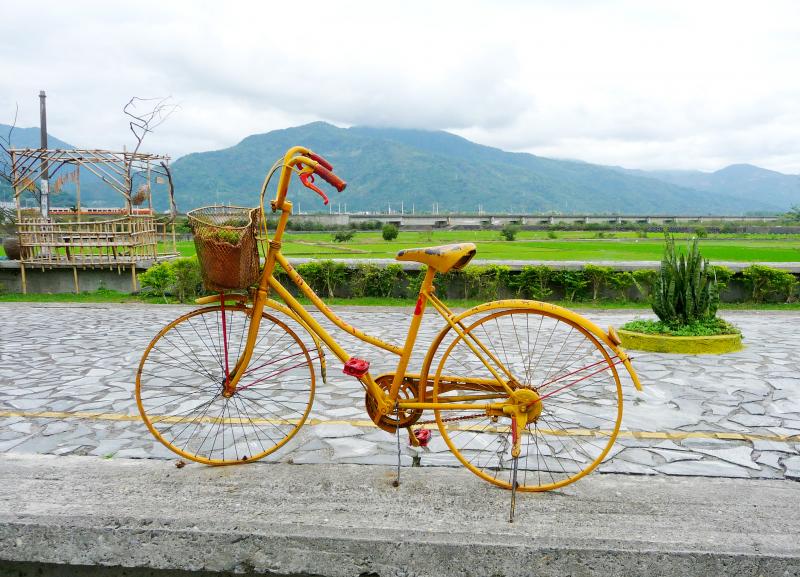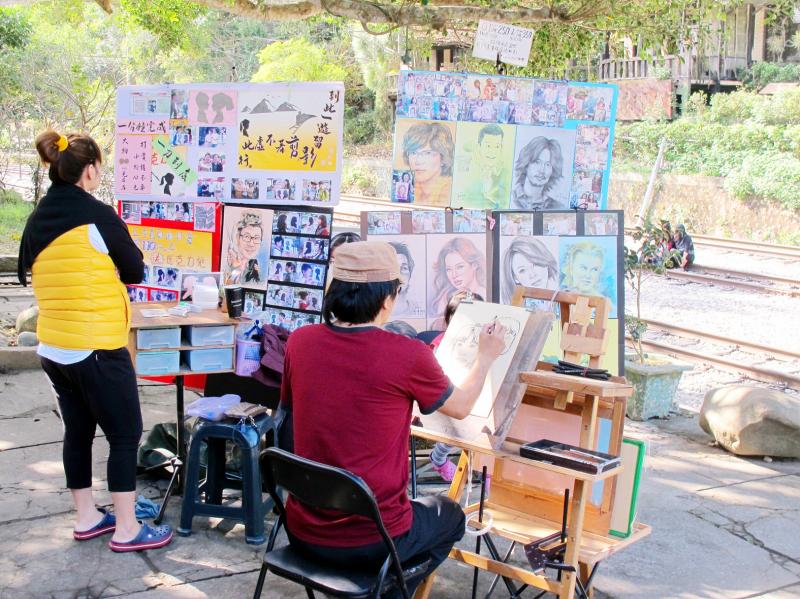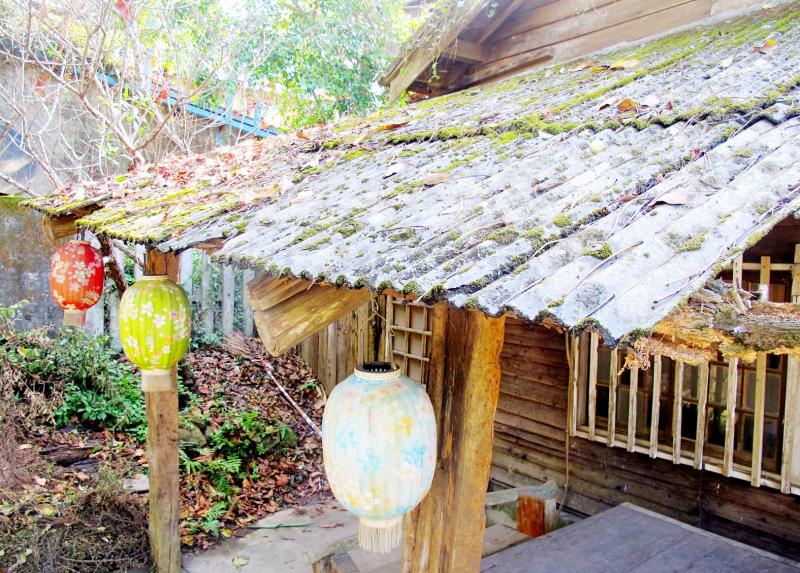For more than a century, Taiwan Railway Administration (TRA) has been connecting the north and south of the nation. Between 1912 and 1926, the rail network was expanded to the eastern counties of Hualien and Taitung.
Even though the number of people living in Taiwan has grown massively — it has more than tripled since World War II — a combination of population outflow in certain places, and a greater range of transportation options, has led to the closure of several TRA stations.
One of the most-visited retired stations is in, and named for, Kaohsiung’s Cishan District (旗山). Until the late 1970s, it was a key stop on the 39.4km-long Ciwei Branch Line (旗尾線), which was built between 1910 and 1912 to link Jioucyutang (九曲堂) on the Western Trunk Line with Ciwei Sugar Factory (旗尾糖廠) and neighboring Meinong District (美濃).

Photo: Steven Crook
The line, which carried rice and bananas as well as sugar and people, was dismantled in 1982. The station at Cishan was left to decay until 2005, when the Kaohsiung County Government listed it as a relic and funded renovation work.
Like many of the railway buildings that date from the period of Japanese rule, Cishan Station (旗山火車站) is single story and mostly made of wood. Yet its resemblance to Taiwan’s most famous colonial-era retired station, at Shengsing (勝興) in Miaoli, isn’t strong. On account of its Tudor-influenced shape, it looks more like the former Chiayi Forest Management Club (營林俱樂部) in downtown Chiayi.
There are frequent buses between Cishan and downtown Kaohsiung, and some from Tainan to Cishan.

Photo: Steven Crook
Between 1903 and 1998, what’s since become known as the Old Mountain Line (舊山線) was the highest stretch of the main north-south railroad. Shengsing Station (勝興火車站), at an altitude of 402m, is an authentic if often crowded tourist attraction. Thanks to its popularity, there’s always plenty going on around the station. Unfortunately, during normal times no public transportation goes all the way to Shengsing.
Many people in western Taiwan aspire to live in the east, but many of those who grew up in the east have moved away from their home villages and towns. Some of the TRA stations shuttered as a consequence have been repurposed into facilities for tourists.
The population of Taimali Township (太麻里鄉) in Taitung County has fallen by almost 30 percent since 1981. Duoliang Elementary School (多良國小) in the south of the township closed its doors in 1999. Duoliang Train Station (多良車站), less than 100m from the school, suspended passenger services in 2006.

Photo: Steven Crook
Few Duoliang residents want to travel by train, but lots of tourists are eager to visit the station. Its appeal is neither architecture nor nostalgia, but rather views of the Pacific Ocean.
Last year, the authorities expanded the observation deck just above the tracks. Even so, on weekends you may have to jostle for position if you hope to capture a train approaching from the south, your friends, the sea and the steep green hillside in a single picture.
Buses linking Taitung City with Dawu (大武) stop on the coast road, from which it’s a short but steep walk up to the station.
Another station on the railroad between Taitung and Kaohsiung, the one at Gujhuang (古莊) near Dawu, was downgraded to a signal installation in late 2017. The closure decision was understandable: For several years, the number of passengers boarding or disembarking here had been below 1,000 per year.
Unless you’ve a technician’s interest in the infrastructure that’s been added to the station during the electrification of the South Link Line (南迴鐵路), there’s no reason to go out of your way to Gujhuang. The two former stations I’ll talk about next are well worth visiting, however.
Unlike Duoliang and Gujhuang — where more than a dozen trains rumble through daily — the former station at Antong (安通), and what’s now called Old Dongli Station (東里舊站), were stranded when the railroad between Hualien and Taitung was rerouted some years back.
The section of track just south of Yuli (玉里) in Hualien was straightened for two reasons: So trains can travel at higher speeds; and to avoid a tectonic frontline where the Eurasian Plate is being pushed beneath the Philippine Sea Plate.
Because of this ever-shifting geological boundary, the road bridge that carries Highway 30 over the Siuguluan River (秀姑巒溪) has to be realigned every three to five years. Back when the railway ran parallel to the road, the tracks required biennial adjustment.
The former railway bridge has been converted into a river crossing for bicycles. It’s part of the Yufu Bikeway (玉富自行車道), a 9.8km-long cycling route that gets its name because it links Yuli with neighboring Fuli (富里).
As you ride or walk across, you may not notice the subtle change in gradient as you go from one tectonic plate to another. Just over 3km from central Yuli, bilingual signs mark the line of convergence; stop here if you want to get a photo with one foot on either plate.
It’s often said that getting somewhere is half the fun. That’s certainly true in this part of Taiwan. The station buildings at Antong and Old Dongli are blandly functional, but whether you make your way to them by bike, motorcycle or car, you’ll certainly enjoy the scenes of rich farmland and forest-covered mountains.
At the time of my last visit, there were no facilities or services at Antong. At Old Dongli, the official end of the bike trail, hot coffee, snacks and souvenirs were available.
If you don’t have your own vehicle, and you’re not interested in renting a bicycle, but want to hike the length of the Yufu Bikeway, be sure to bring a bottle of water, some snacks, a sunproof hat and an umbrella. Consider taking one of the buses that ply Highway 9 as far as Wujiang Elementary School (吳江國小) and from there walk north into central Yuli. Moving in this direction means you’ll be able to sit down for a meal or buy some provisions before catching a train from Yuli to your next destination.
Steven Crook has been writing about travel, culture and business in Taiwan since 1996. He is the author of Taiwan: The Bradt Travel Guide and co-author of A Culinary History of Taipei: Beyond Pork and Ponlai.

April 14 to April 20 In March 1947, Sising Katadrepan urged the government to drop the “high mountain people” (高山族) designation for Indigenous Taiwanese and refer to them as “Taiwan people” (台灣族). He considered the term derogatory, arguing that it made them sound like animals. The Taiwan Provincial Government agreed to stop using the term, stating that Indigenous Taiwanese suffered all sorts of discrimination and oppression under the Japanese and were forced to live in the mountains as outsiders to society. Now, under the new regime, they would be seen as equals, thus they should be henceforth

Last week, the the National Immigration Agency (NIA) told the legislature that more than 10,000 naturalized Taiwanese citizens from the People’s Republic of China (PRC) risked having their citizenship revoked if they failed to provide proof that they had renounced their Chinese household registration within the next three months. Renunciation is required under the Act Governing Relations Between the People of the Taiwan Area and the Mainland Area (臺灣地區與大陸地區人民關係條例), as amended in 2004, though it was only a legal requirement after 2000. Prior to that, it had been only an administrative requirement since the Nationality Act (國籍法) was established in

With over 80 works on display, this is Louise Bourgeois’ first solo show in Taiwan. Visitors are invited to traverse her world of love and hate, vengeance and acceptance, trauma and reconciliation. Dominating the entrance, the nine-foot-tall Crouching Spider (2003) greets visitors. The creature looms behind the glass facade, symbolic protector and gatekeeper to the intimate journey ahead. Bourgeois, best known for her giant spider sculptures, is one of the most influential artist of the twentieth century. Blending vulnerability and defiance through themes of sexuality, trauma and identity, her work reshaped the landscape of contemporary art with fearless honesty. “People are influenced by

Three big changes have transformed the landscape of Taiwan’s local patronage factions: Increasing Democratic Progressive Party (DPP) involvement, rising new factions and the Chinese Nationalist Party’s (KMT) significantly weakened control. GREEN FACTIONS It is said that “south of the Zhuoshui River (濁水溪), there is no blue-green divide,” meaning that from Yunlin County south there is no difference between KMT and DPP politicians. This is not always true, but there is more than a grain of truth to it. Traditionally, DPP factions are viewed as national entities, with their primary function to secure plum positions in the party and government. This is not unusual